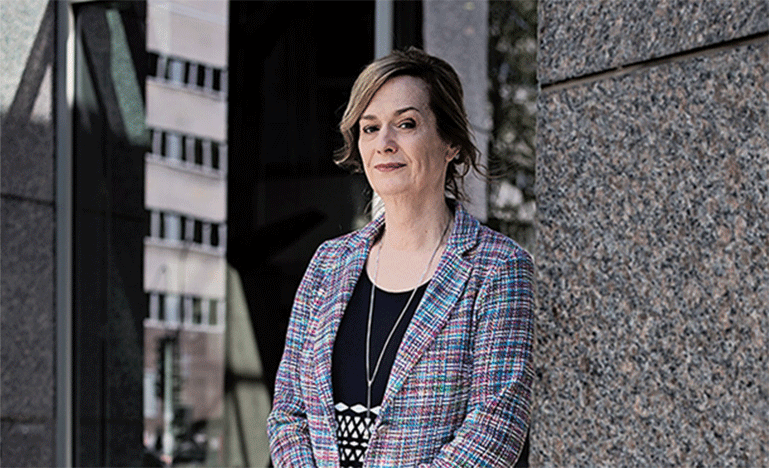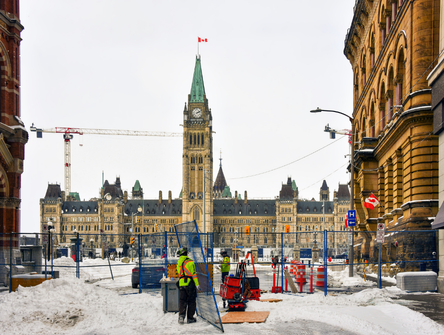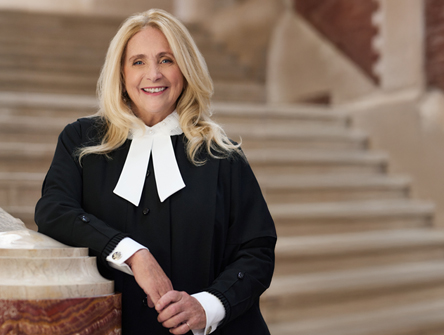Her way: Profile of a transgender lawyer
She wears a conservative navy blue suit and a pink-striped blouse. Her brown hair is lightly streaked and clipped up with a comb and her only jewellery is a simple silver necklace and a plain band on her right hand. Beige eyeshadow highlights her expressive brown eyes and she wears pale pink lipstick. Slim with delicate features, she has a pretty face.

It’s usually inappropriate to focus on the appearance of interview subjects unless they’re Hollywood actors or members of the Royal Family. But Marie Laure Leclercq used to pack her female identity into a suitcase that she carried in the trunk of her car so she could change out of her “suit of armour” when the pain of living a lie as a man named Philippe became overwhelming. Her ability today to live openly and proudly as a trans woman is a personal and professional victory. Her struggle to get to that point is the defining narrative of her life.
An intellectual property lawyer with De Grandpré Chait in Montreal, Leclercq is a champion for the transgender community. She spearheaded the creation of the CBA Quebec Branch Sexual Orientation and Gender Identity Conference (SOGIC) and served as chair for four years. She recently appeared on behalf of the CBA before the Senate’s legal and constitutional affairs committee in support of including gender identity and gender expression as prohibited grounds of discrimination in the Canadian Human Rights Act. She’s also a member of the CBA Board of Directors.
Her ability today to live openly and proudly as a trans woman is a personal and professional victory.
In 2016, she received the CBA SOGIC Hero Award for her work advancing the cause of equality of the LGBTT (lesbian, gay, bisexual, transgender, two-spirit) community. She was elated and surprised, she says now, but demurs at the notion she’s any kind of hero. “My project was just to survive,” she says. “Ultimately, I was pushed by that force to survive and create better congruency in my own living. I became a hero simply by my way of being.”
A traditional track
When Leclercq was growing up in the 1960s, the idea that some people’s gender identity might not match the sex they were assigned at birth was not discussed outside of psychiatrists’ offices. For a shy 12-year-old boy named Philippe Leclercq, thrilled to think he might be developing breasts and feeling a “dichotomy” in his being, that meant confusion and guilt.
Born in Berlin, he was raised in a conservative, religious family by older parents – his mother was 45, his father, 50, when he was born – and had two brothers and two sisters. When he was six, the family moved to Montreal. A gifted student, Philippe entered École Polytechnique de Montréal at age 16 to study engineering physics. Excelling at school “was my way of finding a place for me in this world,” Marie Laure says now. Work as solace became a common theme over the next few decades.
He followed a traditional track, completing a masters degree in electrical engineering, falling in love with a woman named Sylvie and later graduating from law school at Université de Montréal after switching gears on the advice of Sylvie’s father, a prominent businessman. He articled, was called to the Bar, completed an MBA in finance at McGill and was planning to marry Sylvie and start a family. Life seemed to be falling into place. Then she left him. His parents and siblings had moved back to Europe and Philippe suddenly found himself alone.
“That started a very sad period of my life where I once again drowned myself in work and loneliness,” Marie Laure says. Philippe eventually lost his job at a law firm. “Circumstances led me to a crisis in my life. And so it all went bad,” she says, declining to elaborate.
“I was hoping this freedom would be enough for me”
Eventually, Philippe found a job at another firm and in 1989 he fell deeply in love with a woman named Danielle. He was still questioning his identity, but his new spouse gave him the freedom to explore; once a week, he could go out in public dressed as a woman. “I was hoping this freedom would be enough for me,” Marie Laure says.
And for a while it was.
Philippe was also enjoying a lot of success after leaving law for the role of vice-president with a client’s software company. He went on to create a U.S. subsidiary and expand the firm with acquisitions in England and France. “I was so elated,” Marie Laure says. “When you have this kind of life, other problems are put aside and all of a sudden you’re living the dream and you forget the rest of your life.”
He returned to law practice after a change in government led to a reversal of business fortunes, joining De Grandpré Chait in 1996. There, “my transgender situation came back with a vengeance and I started consulting professionals.”
The arrival of the internet was a boon to individuals like Philippe who were looking for answers. Danielle had left and he was growing weary of trying to battle his nature through sheer will. “You cannot deny part of your reality,” Marie Laure says. Online research led to a support group at Montreal General Hospital where individuals thinking of transition at that time encountered a series of barriers.
“The intention was to push us to ‘forget about our project,’” Marie Laure says flatly. “They wanted to save our lives; they were too aware of the almost impossibility of making a success of our lives after making a change. They knew the suicide statistics.”
"They wanted to save our lives"
The internet also led her to a trans woman named Olivia who remains a good friend and support. A McGill University professor who successfully transitioned in the 1990s, she had a key factor working in her favour, Marie Laure points out: security of employment.
(The 2010 Ontario Trans PULSE project revealed that 13 per cent of transgender individuals surveyed had been fired and 18 per cent were refused employment based on their transgender status. It also found that 35 per cent of trans Ontarians surveyed had seriously considered suicide and 11 per cent had attempted suicide in the past year.)
In 1995, Philippe saw a psychologist and started the transition process. “It was really torture facing that decision,” Marie Laure says. One of her brothers begged her not to proceed. “He pushed me, he told me: ‘Don’t do it. I’m sure you’re going to find a way,’” she said. “For people who loved my former self, you know, they were losing a friend; for my brother it was losing a brother. And they were really thinking that I was crazy.”
Her two brothers never spoke to her again.
At that time, individuals were required to have the advice of two professionals and do a “real life” test – living in the opposite gender – for one year before undergoing sex reassignment surgery. Philippe had already taken some small steps – taming his beard with electrolysis, wearing his hair longer and slicked back – but this meant being open with his firm and his clients about his situation and his plans.
The greatest challenges were still ahead.
Going public
Eric Lalanne, president of De Grandpré Chait’s management committee and chairman of the board, was head of the commercial litigation group and a board member when Marie Laure took her first tentative steps toward a new identity. So he had a front-row seat to the consternation which greeted her decision to live as a woman before undergoing sex reassignment surgery.
“She had approached our president at the time who made a report to the board,” he said in an interview. “And the consensus was, it’s not something you can turn your back to; it’s happening, we have to understand all that it implies and we have to be there and give the proper support.”
Furthermore, “it was certainly the belief that if we were to use this as a means to terminate the relationship, that it would only lead to lawsuits,” he adds. “So it was a sense of responsibility both toward the firm and toward the individual.”
Philippe Leclercq was considered the go-to lawyer in the IP department. But some clients still refused to work with him once news of his plans became public.
“I believe the initial reaction was that if someone is that confused about his or her personal standing, can that person provide all the professional services that a client is entitled to?” Lalanne says. “There seemed to be, at the time, the apparent conclusion that if you were going through such changes you were not mentally fully competent.”
Marie Laure remembers a client who represented about 50 per cent of her business then. She told the firm’s president that she would meet with him to explain the situation.
“I came with a picture of me as a woman,” she says. “It was quite courageous on my part. And he said: ‘Oh, no problem, don’t worry – my most important co-workers are women, go ahead.’ I was completely happy. Two months later, that client left and I’ve never seen him again. I had been his most trusted adviser for 20 years, so it was kind of a shock.”
But most clients remained and the firm continued to be supportive. There were some issues: Philippe had to use a guest washroom near reception during his transition and for a year or two afterward. Before having surgery, he could not legally use his new name – he had chosen Marie Laure because his mother had expected a girl and that’s what she planned to call her – so he had to doctor his business cards.
Simply put, the internal gender identity of transgender individuals does not match the sex they were assigned at birth.
The support staff was shocked and some of the more conservative older members of the firm did not approve. What would Philippe look like after the operation? A drag queen? Something equally outlandish?
“I think that’s what fuelled part of the prejudice at the beginning,” Lalanne says. “What kind of person are we going to have in front of us? And they were imagining the worst of all possible scenarios, I’m convinced.”
Marie Laure made her coming out at the firm’s holiday party dressed in a long, black suede skirt and matching jacket. She was accompanied by Lalanne and another lawyer. “It was a very emotional moment, let’s put it that way,” he remembers. “She was all class and grace in her approach that night and it certainly gave me the sense that what she was about to go through was a positive thing. And I was very proud to be by her side.”
It had been clear to anyone who knew him even slightly that Philippe was a troubled individual, Lalanne adds. “Nobody within our ranks back then who saw or met [him] would conclude that this person was the happiest in the world. He was a tortured individual and that was quite obvious.”
For Marie Laure, that night was the start of seeing life in colour instead of black and white. “That’s really, really what you live,” she says. After living as a woman for a year, she travelled to the United States for two-step (chest and genital) surgery. “I said to the anesthesiologist: ‘Now I am putting an end to my [present] life.’ “When I woke up, it really was a different person.
“I never regret it. Every morning when I look in the mirror, I think I’m a much better person.”
An individual process
It is important to note that Marie Laure’s story does not represent the full spectrum of the transgender experience. Not everyone who identifies as transgender wants to have surgery or otherwise alter their physical appearance to correspond with their felt gender.
Simply put, the internal gender identity of transgender individuals does not match the sex they were assigned at birth. Typically, transgender people match their gender expression – external cues such as name, clothing, hair, body characteristics – to their gender identity rather than their birth gender. How far they decide to go, however, depends on the individual.
The Trans PULSE research study found that 30 per cent of transgender Ontarians live their day-to-day lives in their birth gender while 23 per cent live in their felt gender without any medical intervention (The Trans PULSE project examined the impact of social exclusion on the health of transgender people in Ontario. It surveyed 433 transgender individuals over the age of 16 who lived, worked or received health care in Ontario.)
Of those who had undergone medical intervention, 42 per cent use hormones that reduce endogenous hormone levels to eliminate secondary sex features of their birth sex; 15 per cent of those on the male to female spectrum had vaginoplasty; and 0.4 per cent on the female to male spectrum had phalloplasty.
It’s also a myth that transgender individuals are simply confused about their gender.
It’s also a myth that transgender individuals are simply confused about their gender. The Trans PULSE study found that 59 per cent had identified their gender identity before the age of 10; 80 per cent by age 14 and 90 per cent by age 19.
A different world
A lot has changed since Marie Laure started her journey as a trans woman. Today, transgender individuals don’t have to live for a year in the opposite sex before having surgery and most provinces no longer require proof of surgery to change name and gender on identification documents.
The federal government caught up to the provinces on the human rights front with the passage of Bill C-16. In 2002, the Northwest Territories was the first Canadian jurisdiction to explicitly prohibit discrimination against trans people by including gender identity in its human rights code. In June, the Yukon government added protection for gender identity and gender expression. Other provinces have statutory protection on one or both grounds or protection is implicit in the law.
But despite much progress many challenges remain. Public health care coverage for gender/transition-related medical treatments and surgical procedures varies across the country and there’s a shortage of trained specialists. And a strong rights framework does not end discrimination overnight: the Trans PULSE study reported that 98 per cent of respondents had experienced transphobia; 96 per cent had heard that transgendered persons are “not normal.”
Still, it’s a very different world from the one Marie Laure encountered. “When I made my change, it was already quite something that the law firm decided to keep me,” she says. “I started a presentation yesterday [about transgender issues], saying: “You’re probably going to yawn…Transgender again,” she laughs.
For those who struggle with their identity, however, the journey is still a difficult one. Asked what she would advise, she has one word: prudence. Don’t rush into a program. Take your time. There is no rush.
“Like my Zen teacher used to say: ‘Another hat, another spouse, another gender won’t do the trick,’” she says with a smile.
“At some point, some inner work is deeply recommended. You don’t want the solution that will become a bigger problem than the problem you’re trying to solve.”
The CBA & transgender rights
2017
Bill C-16: Amendments to the Canadian Human Rights Code and the Criminal Code (gender identity or expression)
The CBA said the bill represents a long overdue step to include these protections expressly in areas of federal jurisdiction. It will provide “tangible protections for one of Canada’s most vulnerable minorities, contribute to broader public awareness of gender diversity issues and advance equality in Canada.” The legislation passed in June.
2016
CBA Council passes a resolution urging governments at all levels to adopt policies and training procedures to protect the rights and accommodate the needs of trans prisoners. In June 2017, CBA's Sexual Orientation and Gender Identity Section and the Criminal Justice Section made recommendations to the Correctional Service of Canada on policies regarding transgender prisoners.
2010
CBA Council passes a resolution urging the federal, provincial and territorial governments to amend laws to ensure equality for all regardless of gender identity or gender expression.
Terminology
Cisgender
A person whose biological sex assigned at birth matches their gender identity.
Gender expression
External manifestations of one’s gender identity often expressed through ‘masculine’, ‘feminine’ or other gender-specific behaviours.
Gender identity
A person’s conscious sense of maleness and/or femaleness. This sense of self is separate and distinct from biological sense.
Gender Queer, genderqueer
People who ‘blur’ gender norms. May identify as either male, female, both, neither or may reject gender altogether.
Intersex
A person whose biological/anatomical sex is outside conventional classification of male or female due to genetic, hormonal or anatomical variations. Not interchangeable with transgender.
Transgender
A person whose biological sex assigned at birth does not match their gender identity.
Two-Spirit
Umbrella term for a wide range of mixed gender roles found in some First Nations and Aboriginal cultures. May incorporate sexual orientation, gender identity and gender expression.


